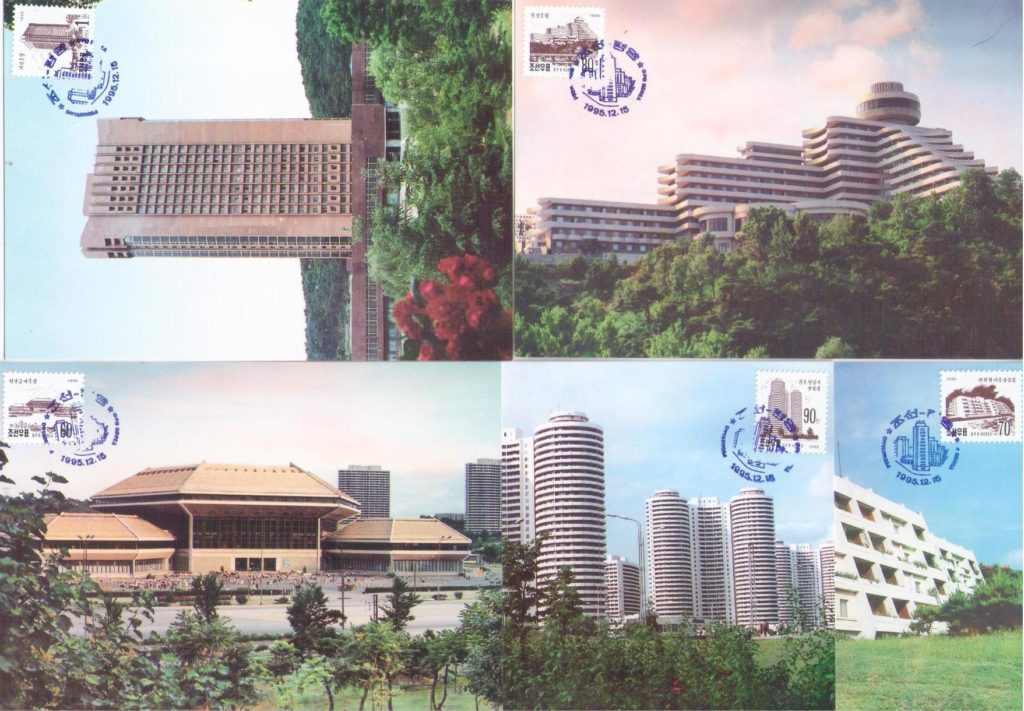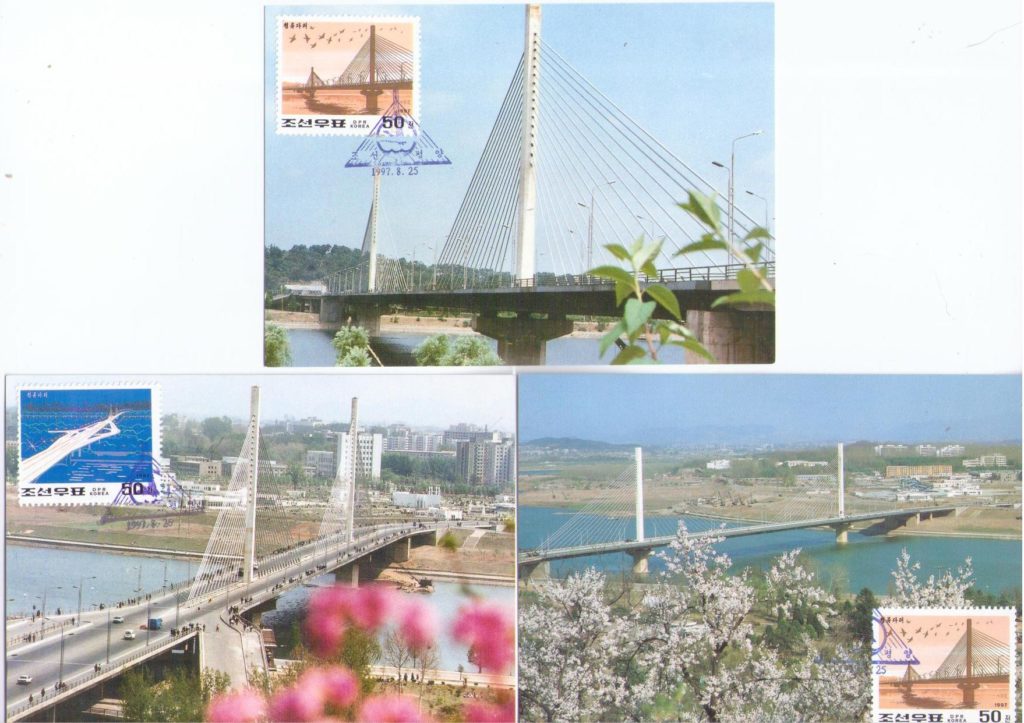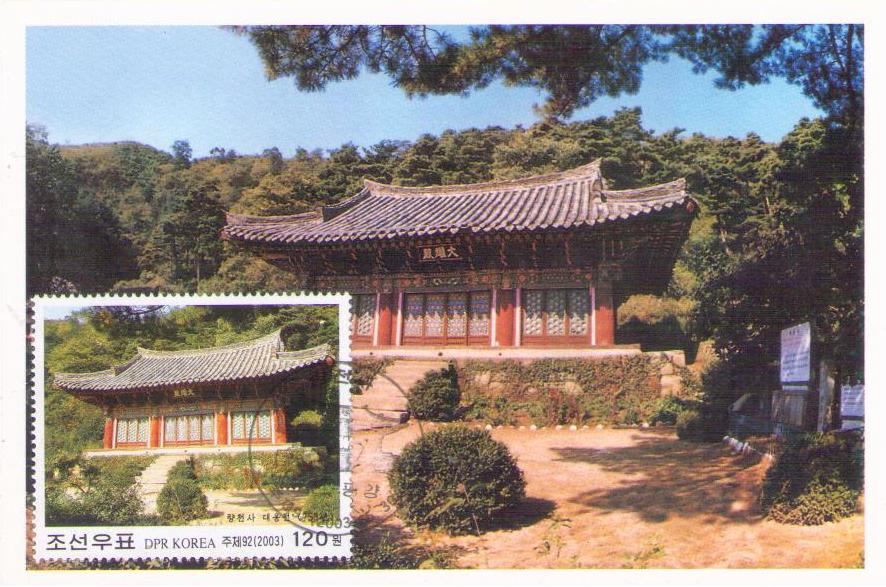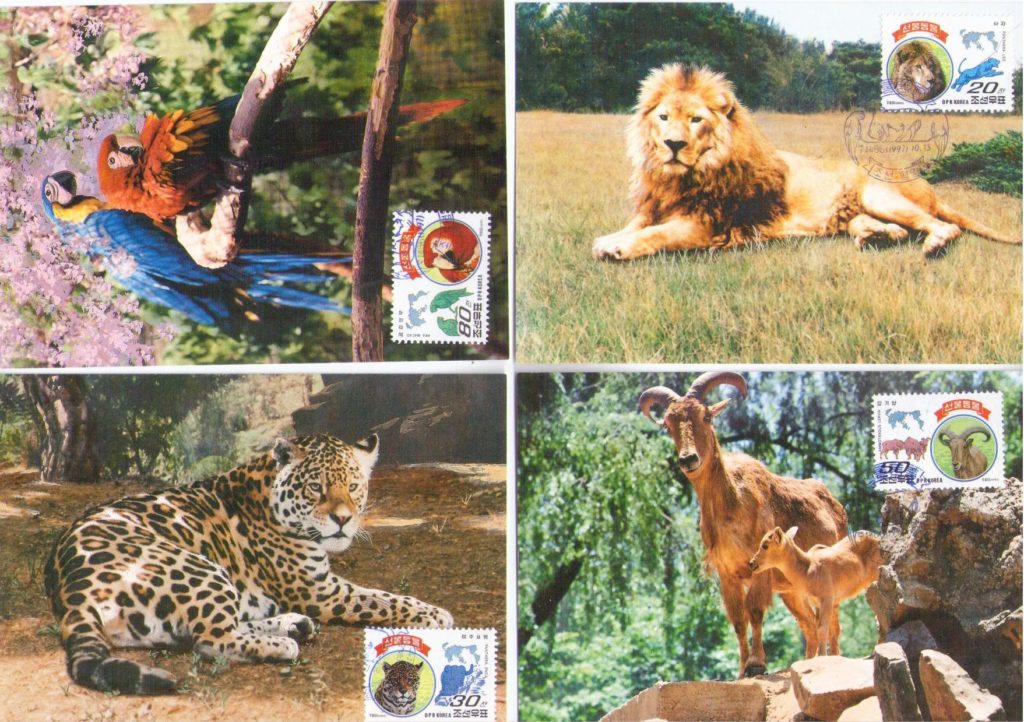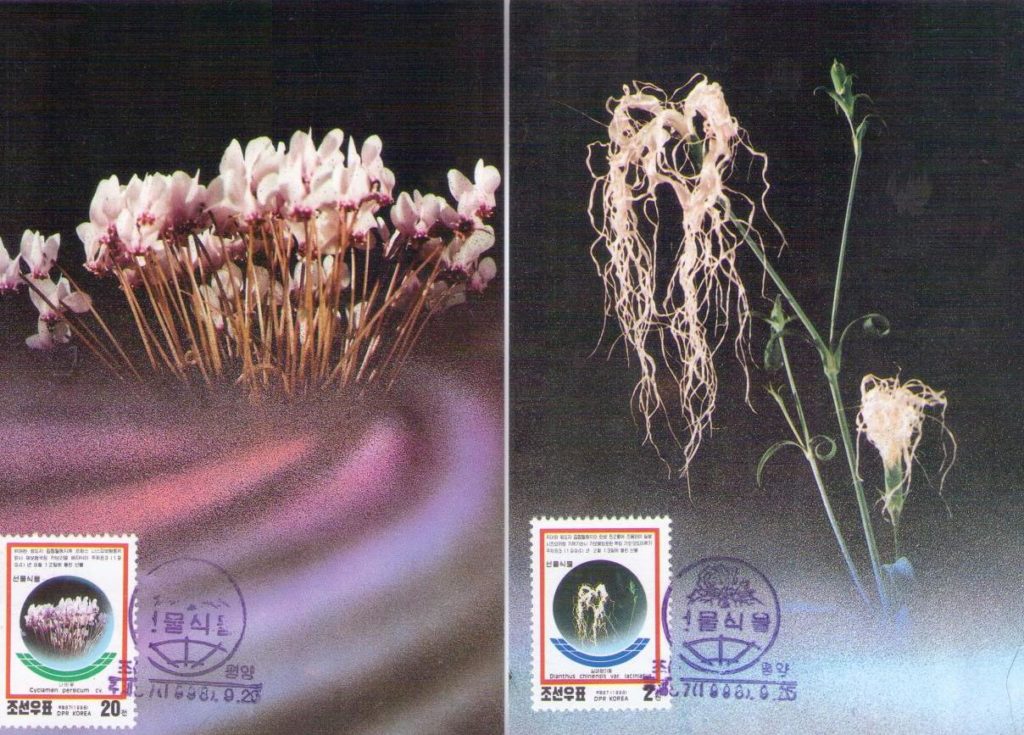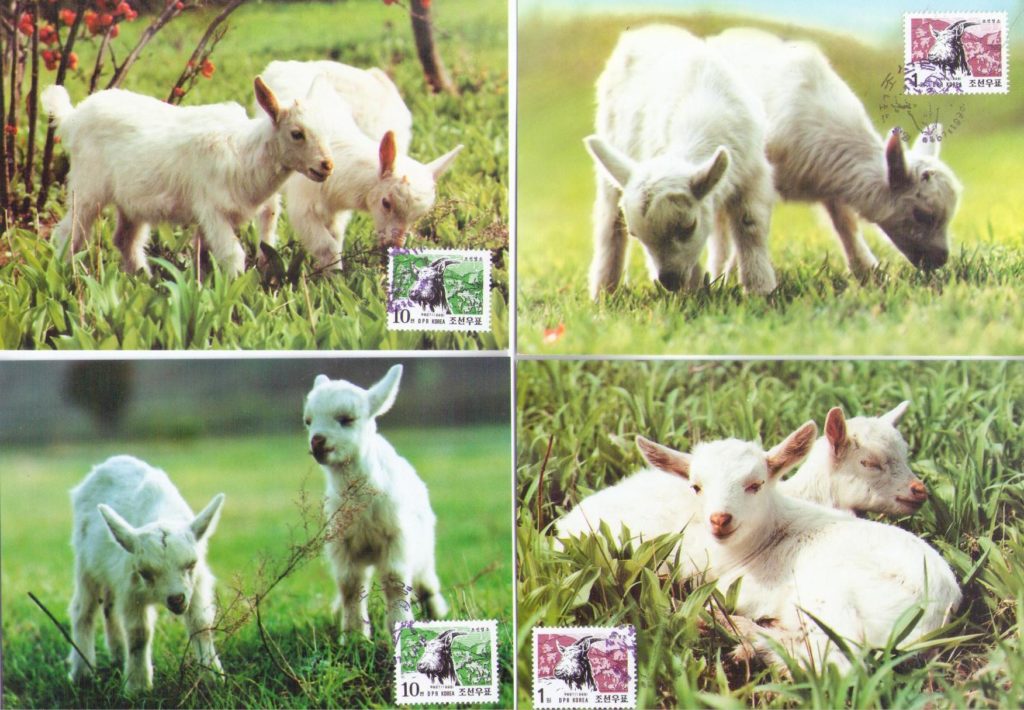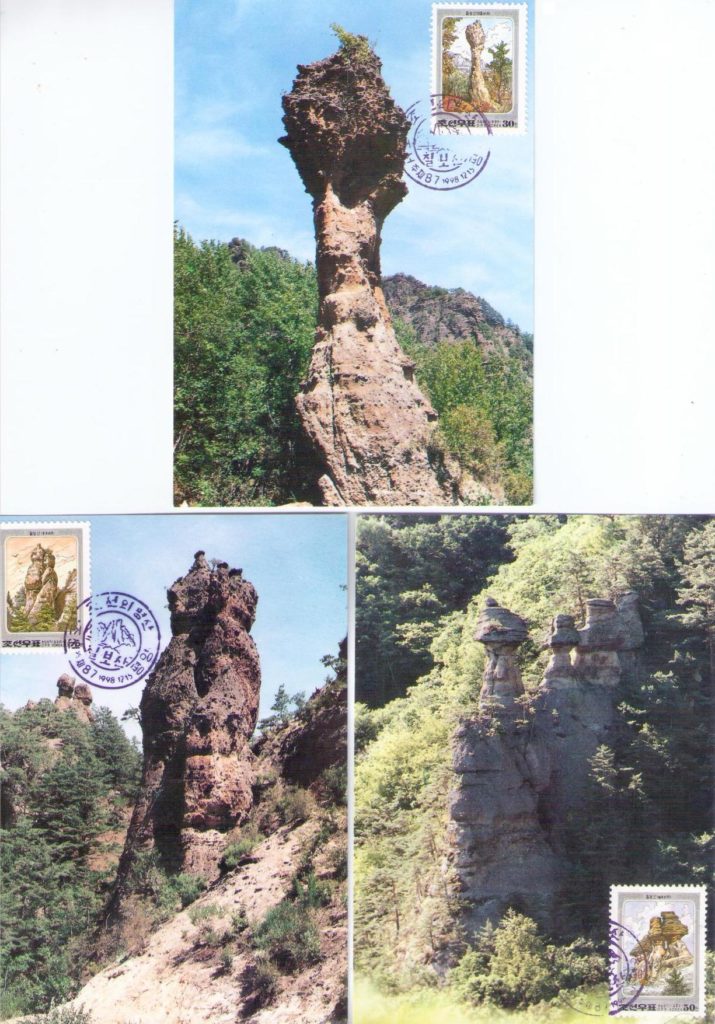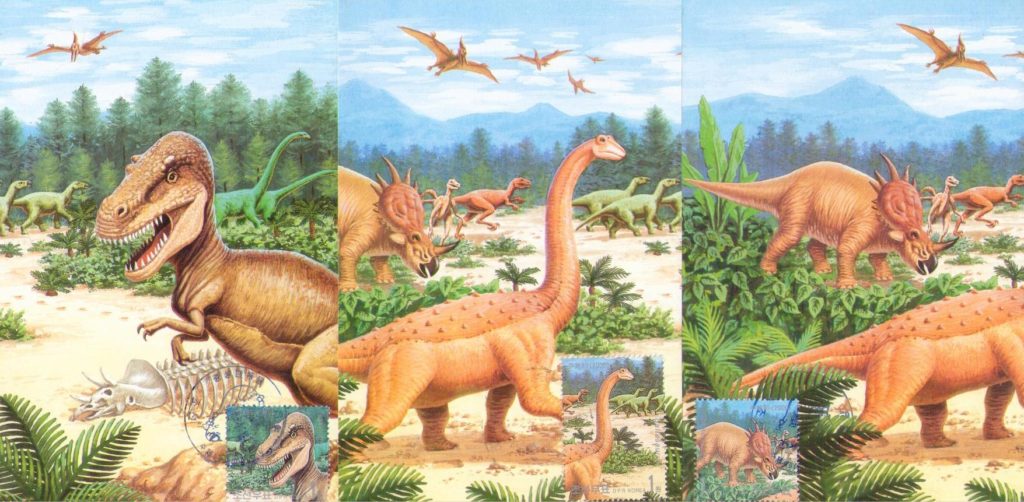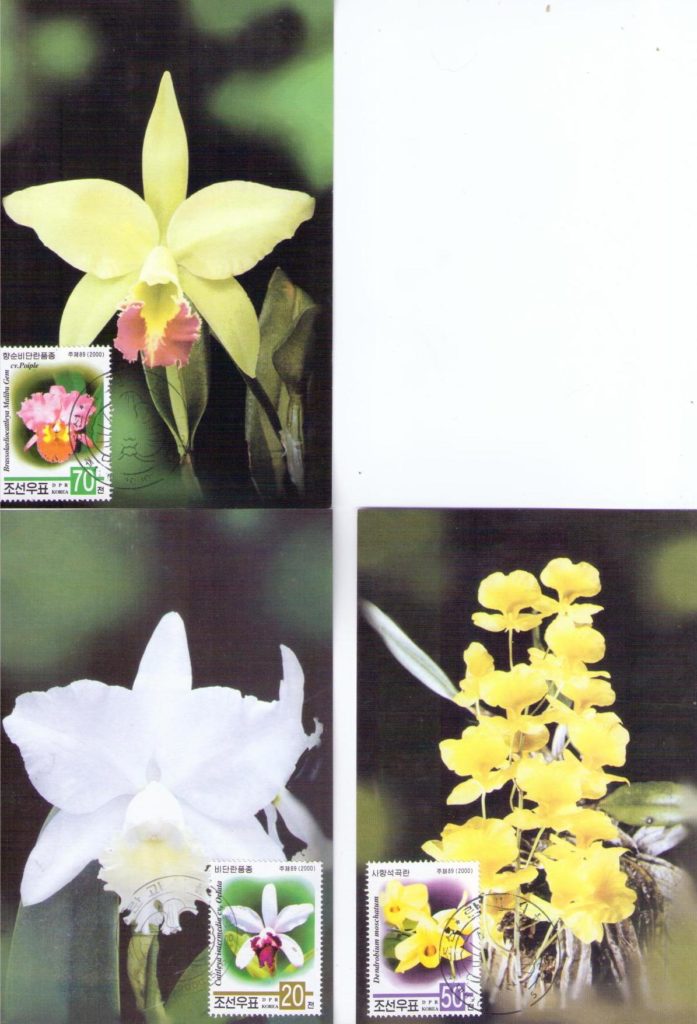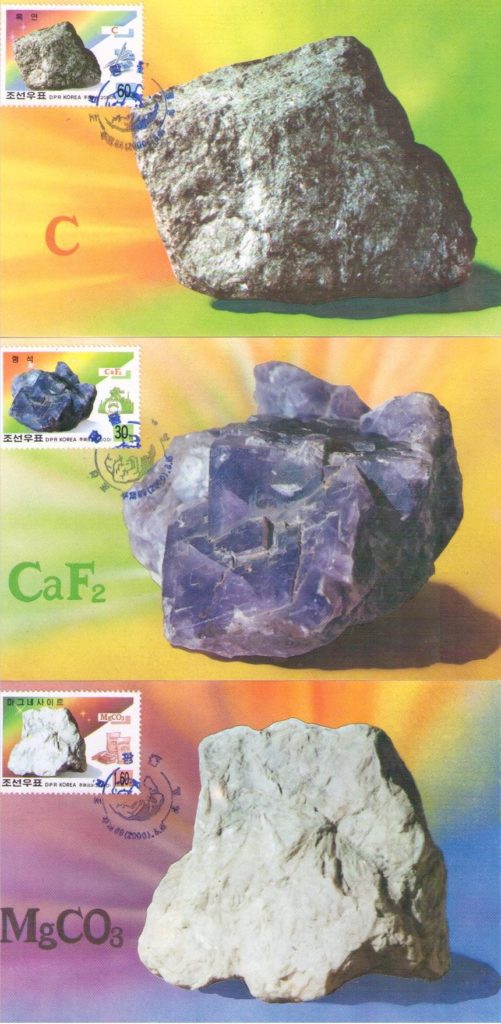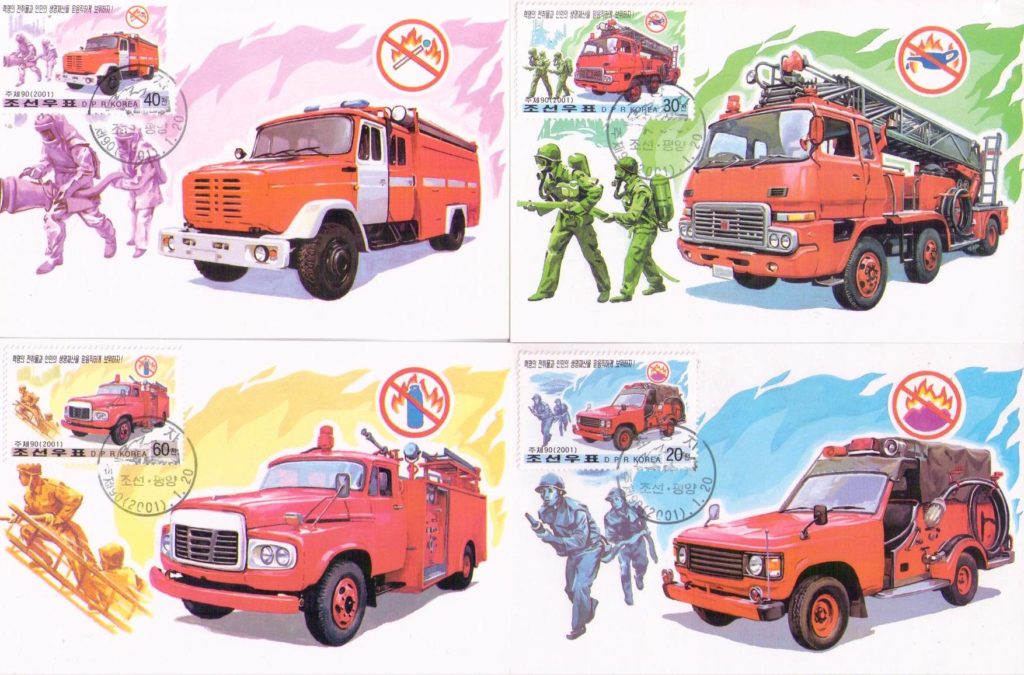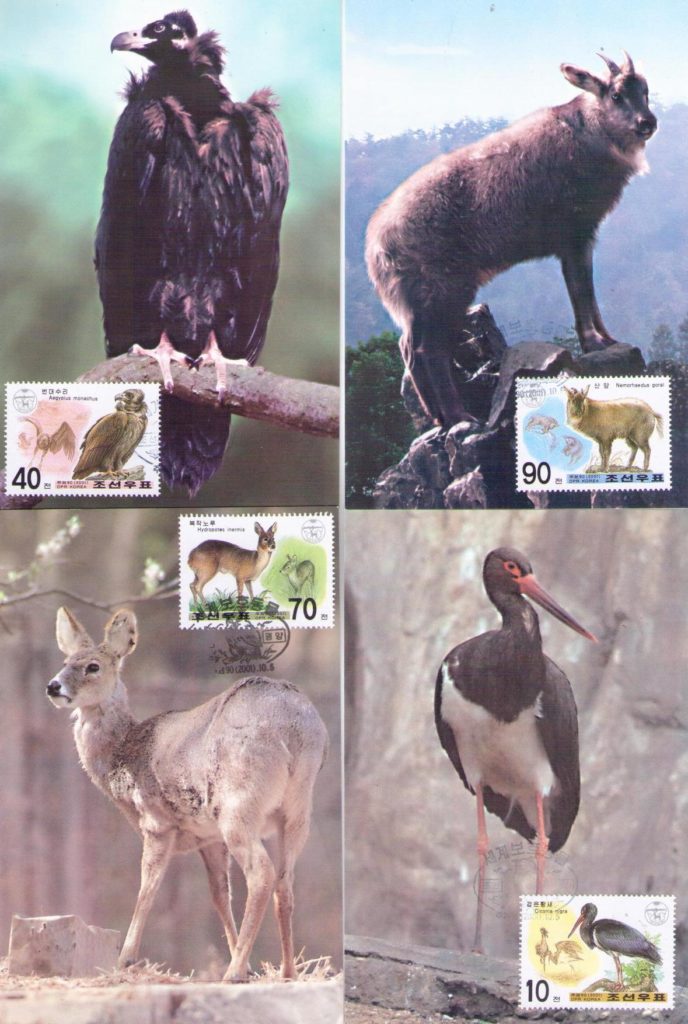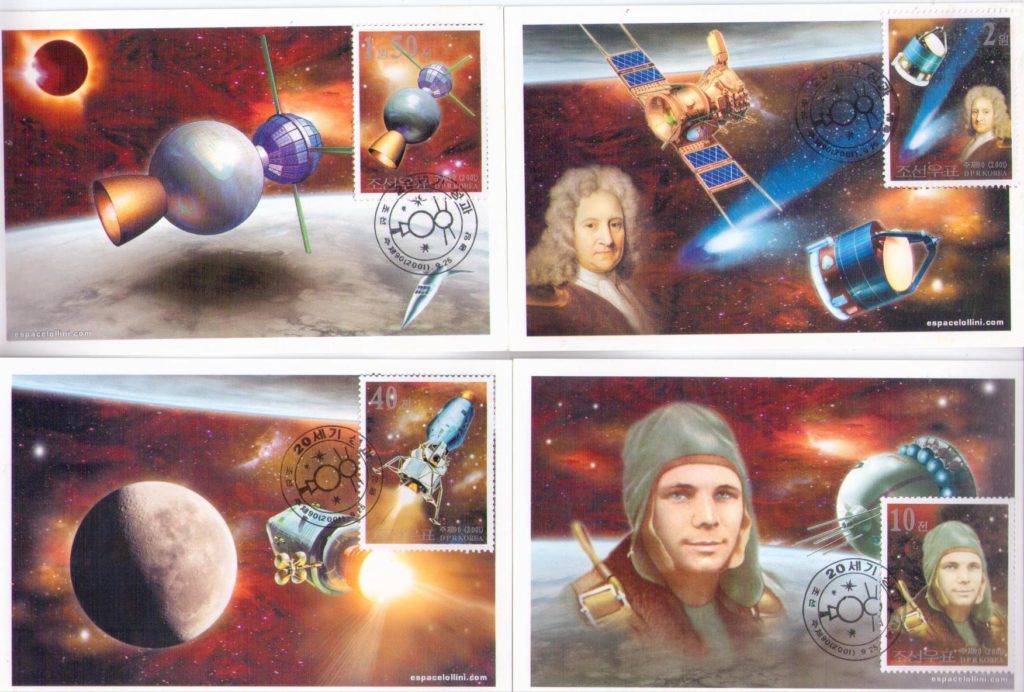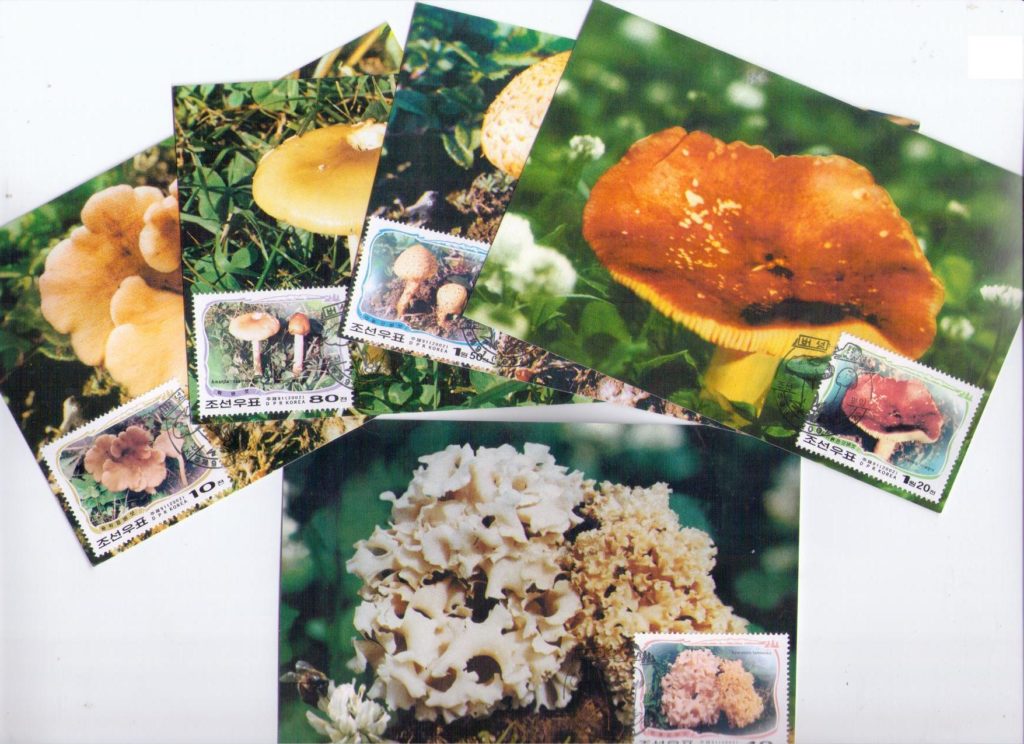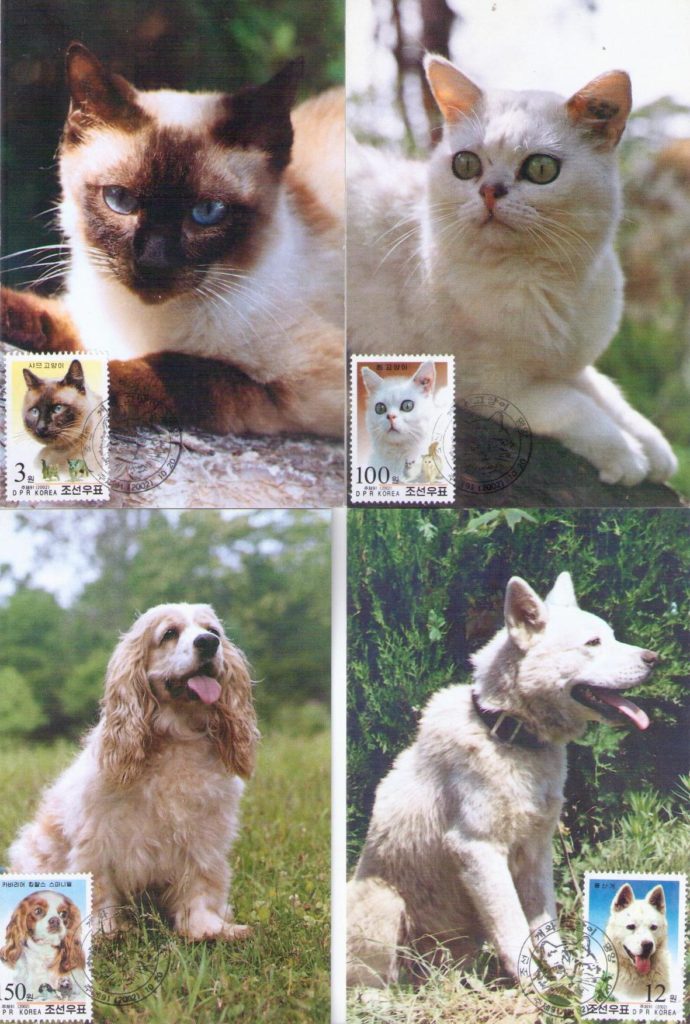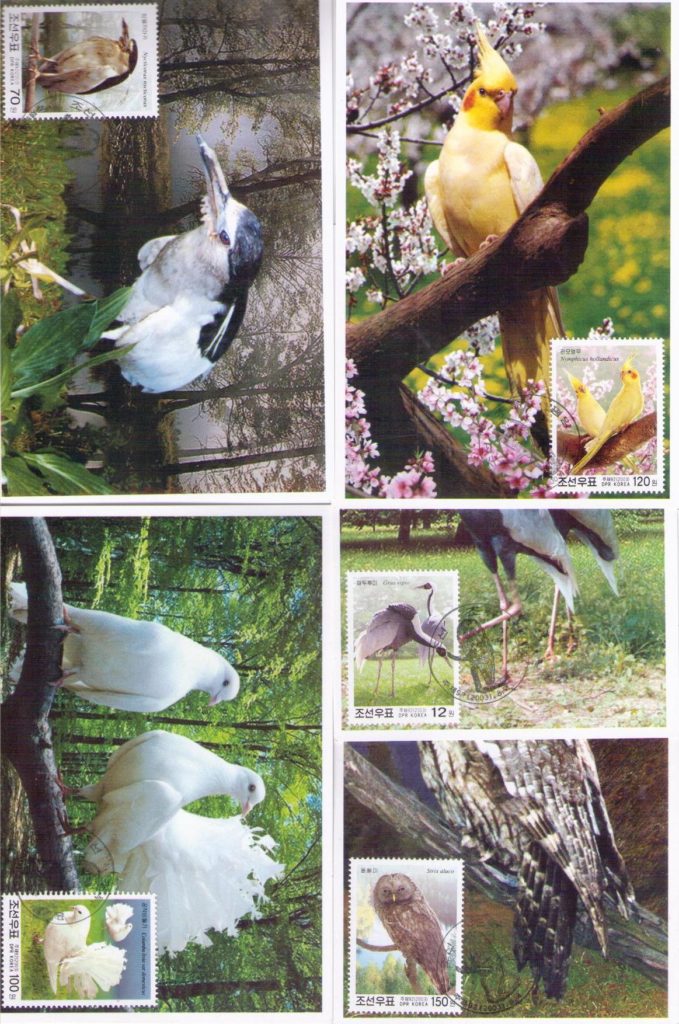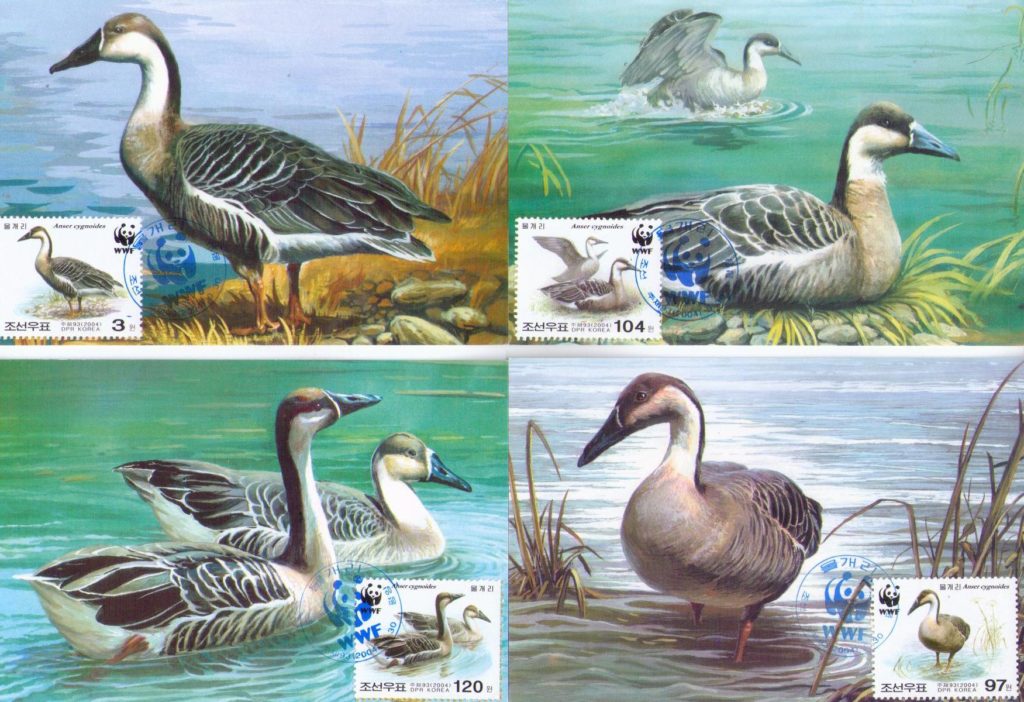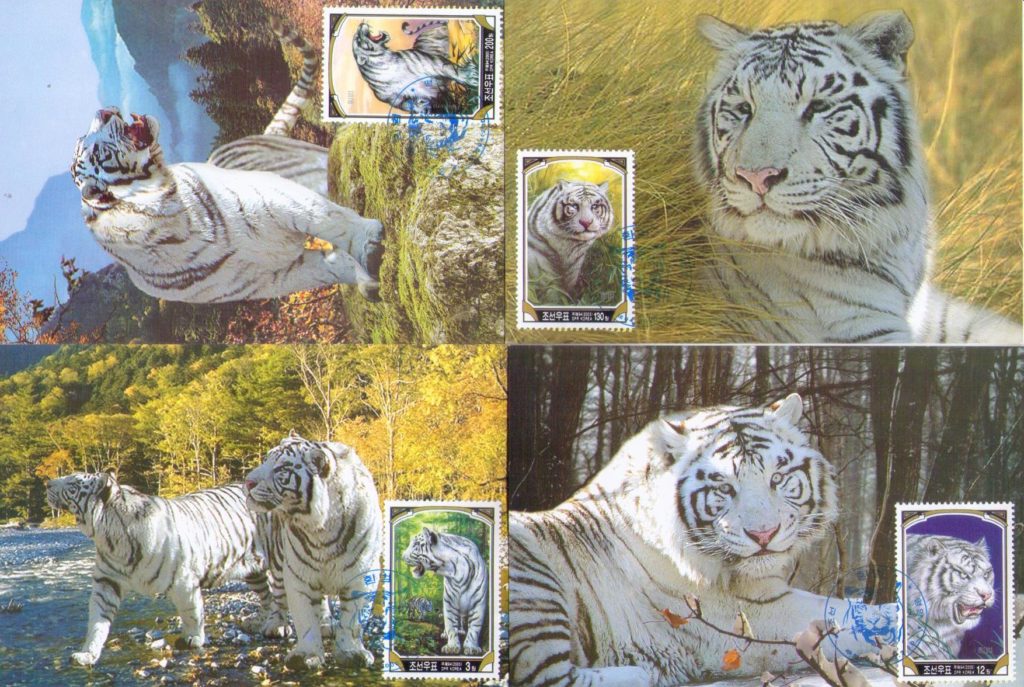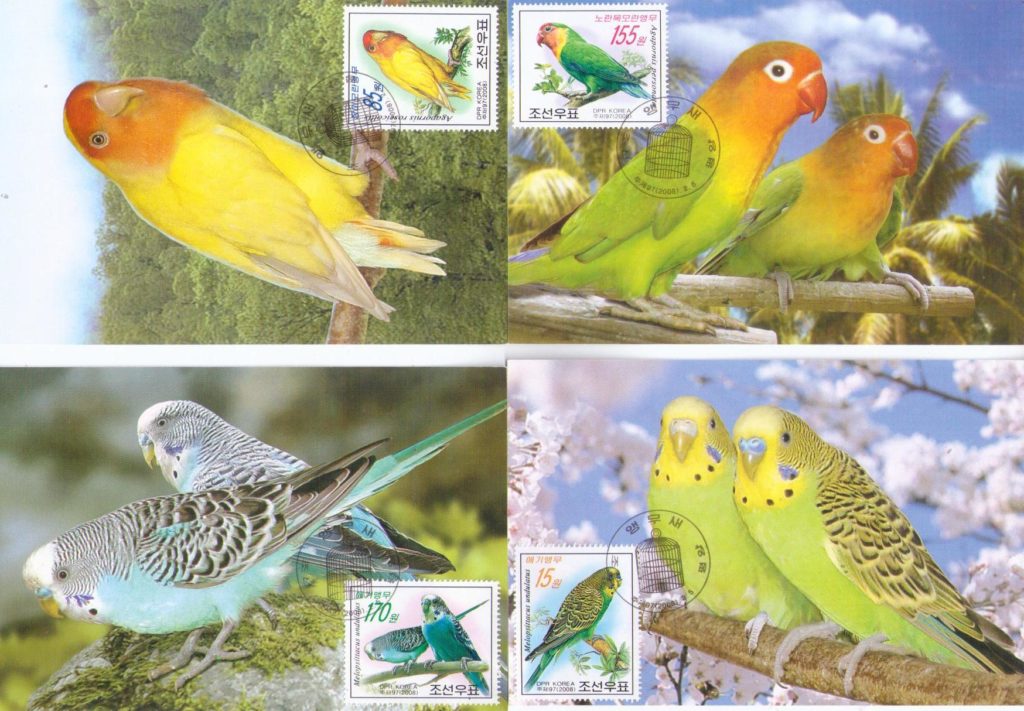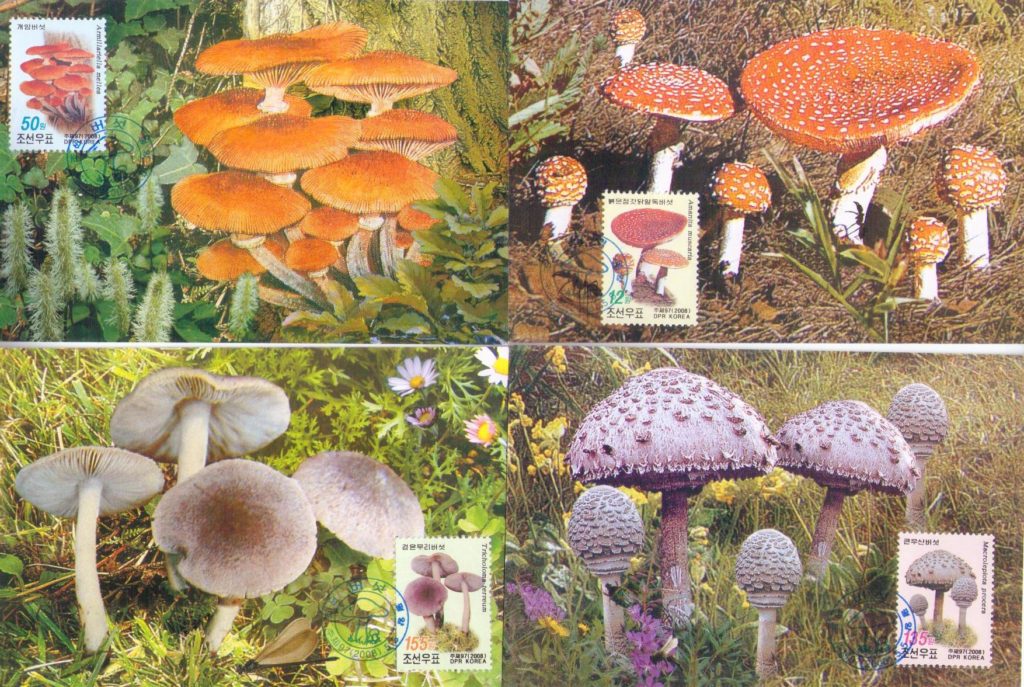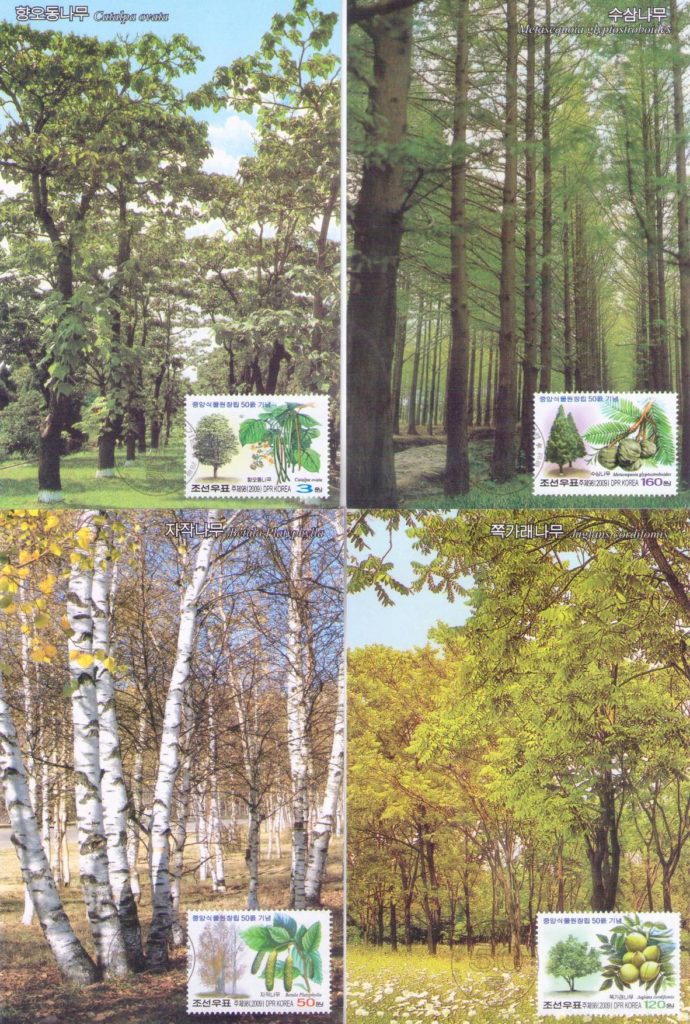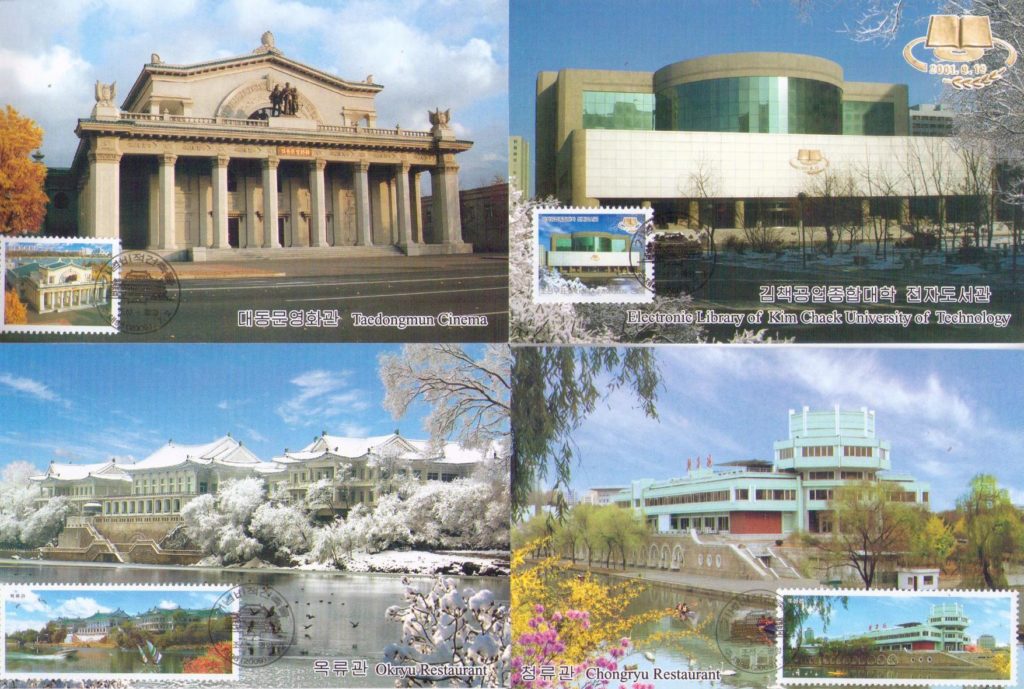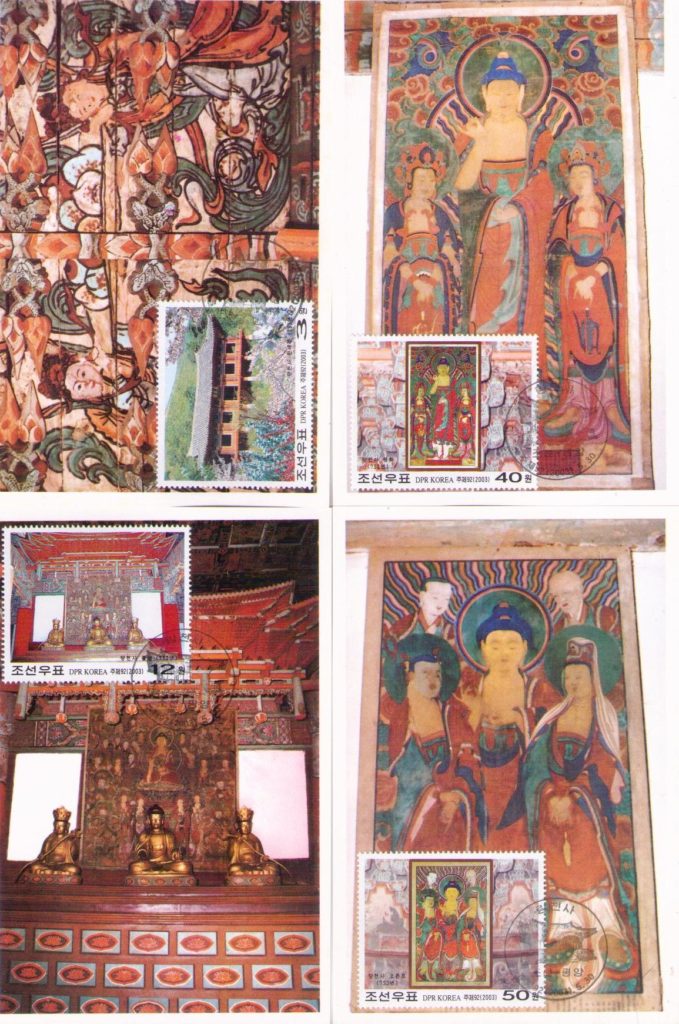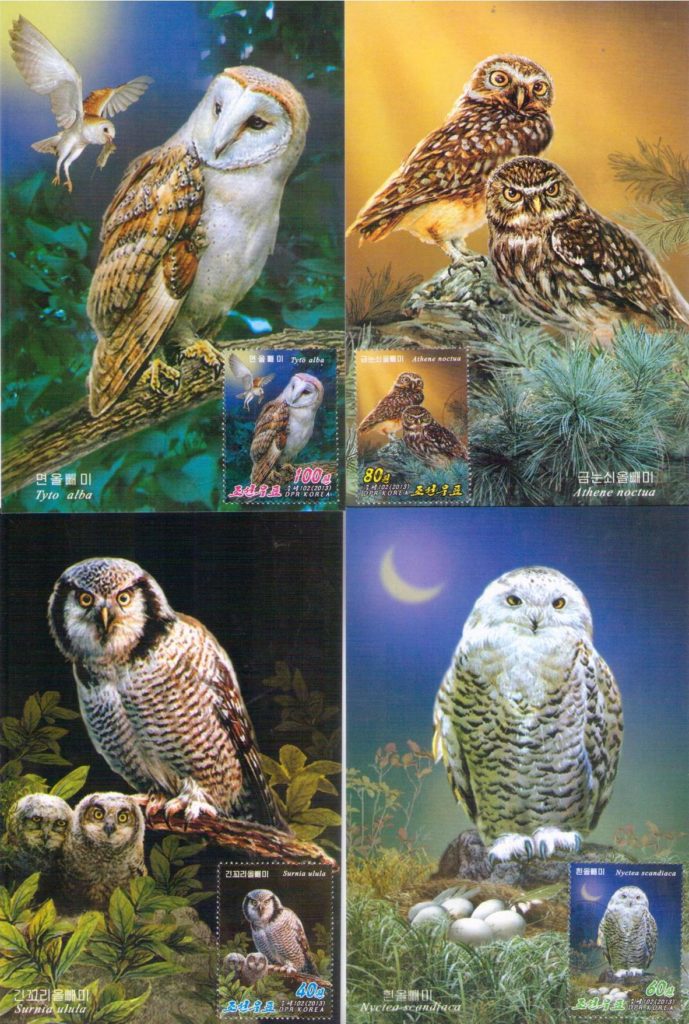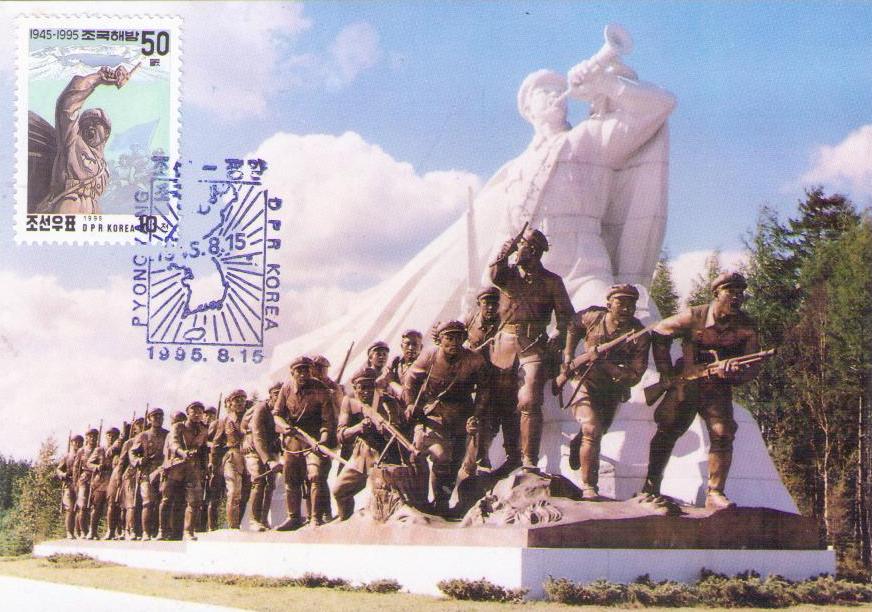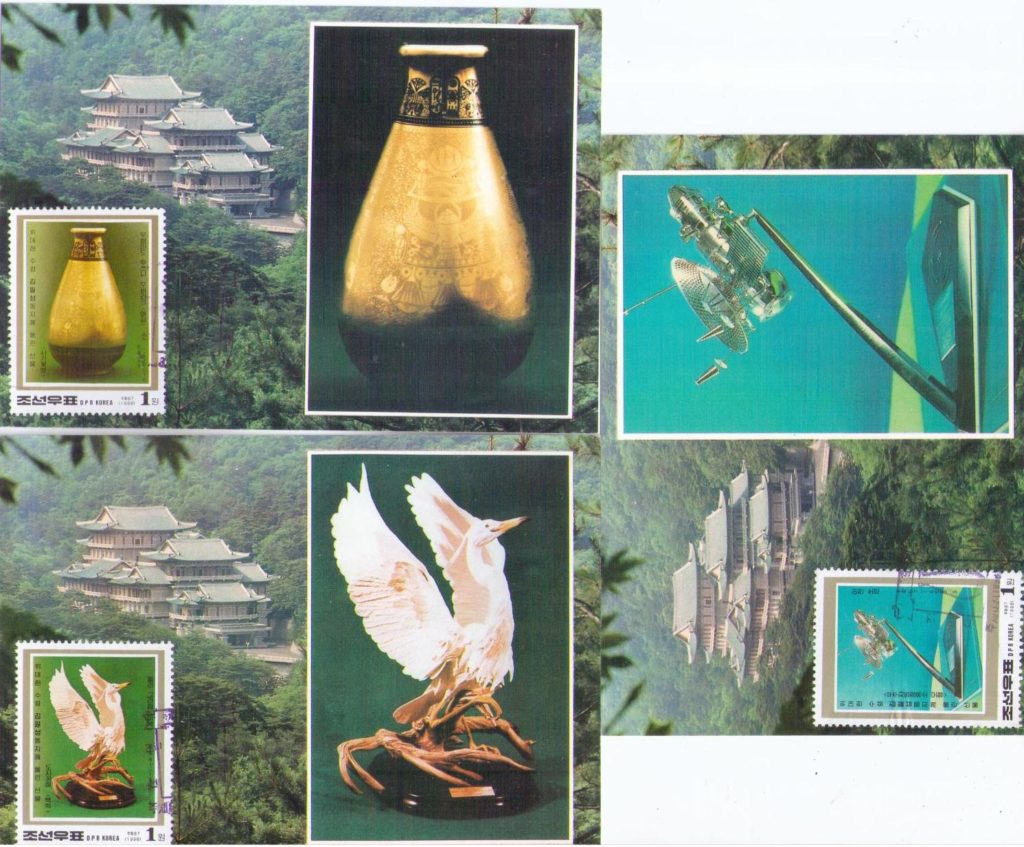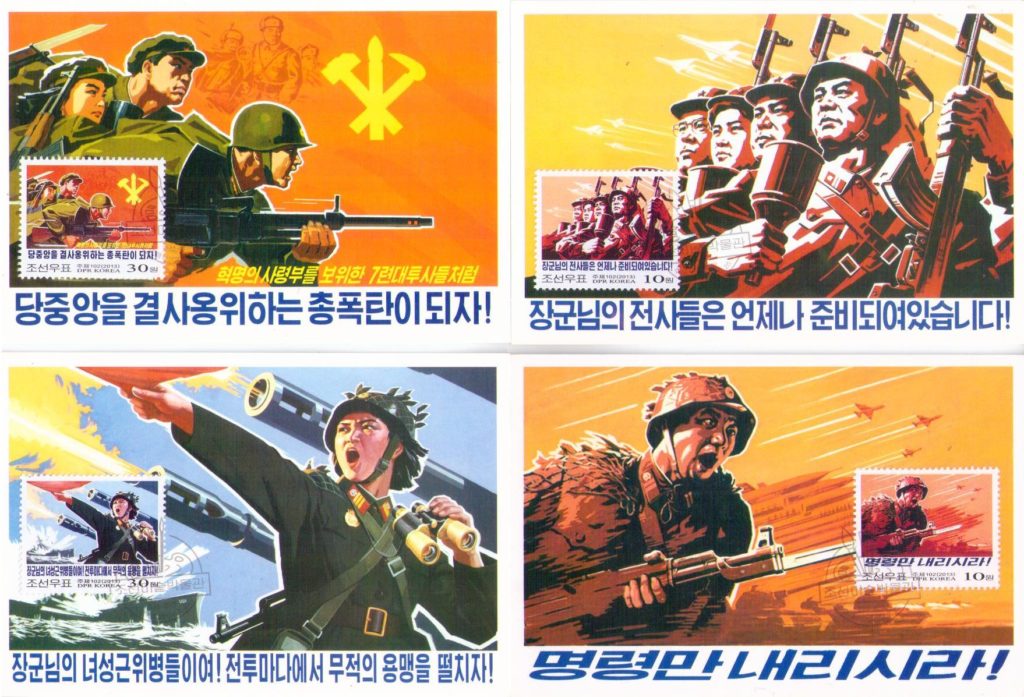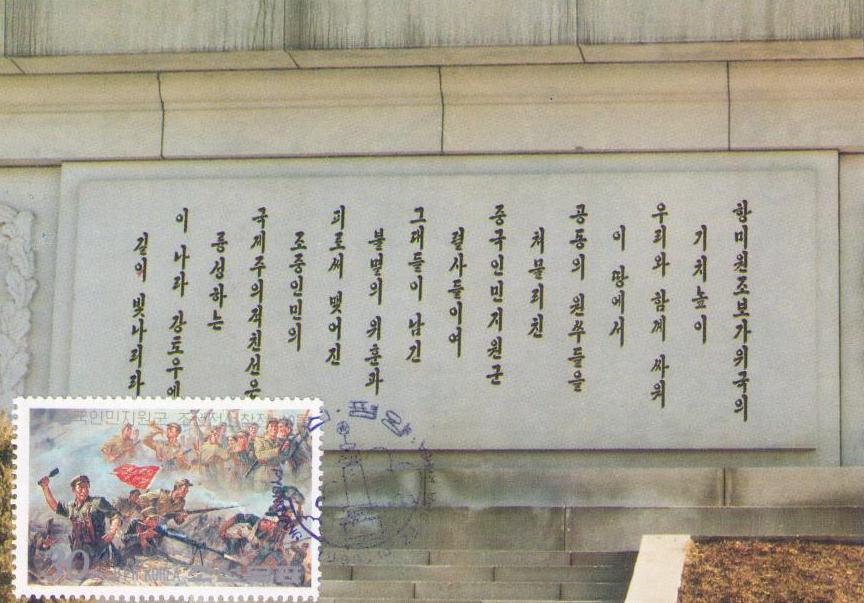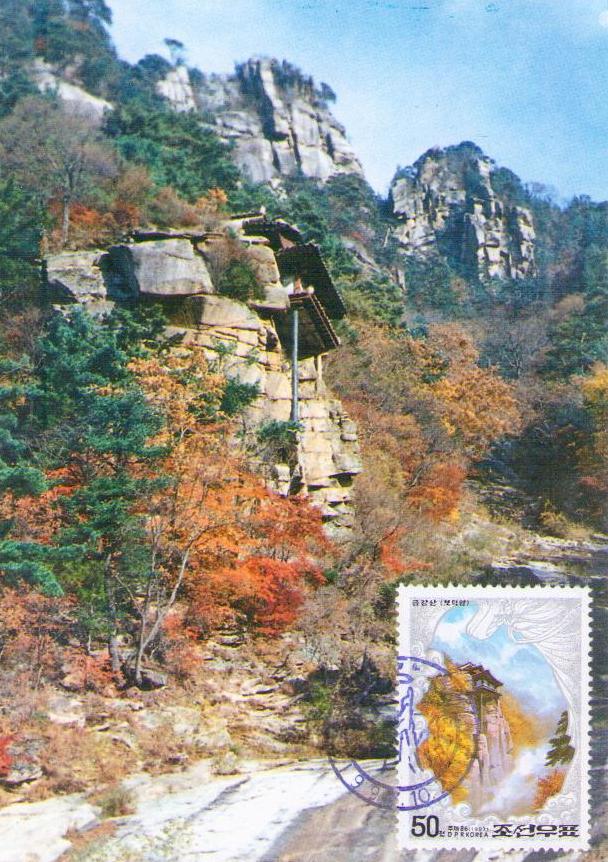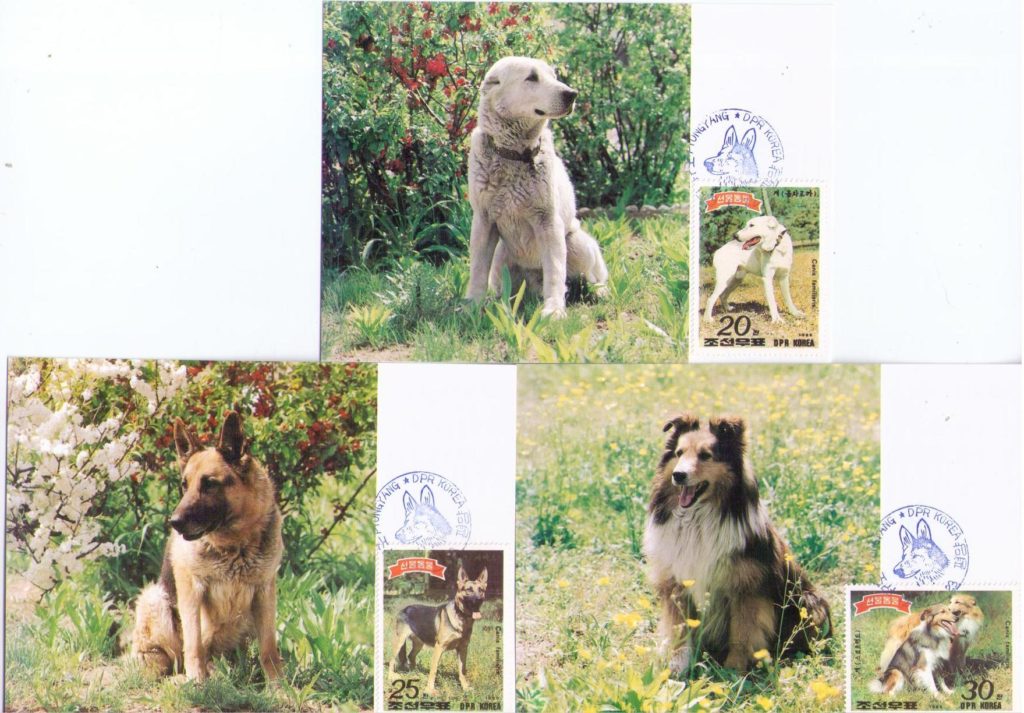-
Pyongyang buildings (set of 5) (DPR Korea)
All or part of each of the five cards in this set are visible in the scan. The buildings are readily identifiable through Korean-only captions. Grade: 1
-
Paektusan Prize (set of three) (DPR Korea)
A set of three unused 1996 maximum cards representing the 5th “Paektusan Prize” International Figure Skating Competition. There are no special captions on the reverses, just a reference number ㄱ-507101. Grade: 1
-
Bridges (set of three) (DPR Korea)
Set of three unused cards from 1997. Strangely–though we know we should never say this–two are captioned only in Korean, and the third (Rungra Suspension Bridge) in both Korean and English. Grade: 1
-
Kumgang, Podok Hermitage (Maximum Card) (DPR Korea)
Unused 2003 card, captioned only in Korean. It’s really a large stamp. An official website says “situated in the delightful Manphok Valley of Inner Kumgang, the buildings were constructed in 1675 during the Ri Dynasty.” Grade: 1
-
Animals (set of four) (DPR Korea)
A set of four unused cards from 1997. Captions are only in Korean. Grade: 1
-
Plants (set of two) (DPR Korea)
This set of two unused 1998 maximum cards has extensive Korean-language captions, though the scientific names are there in the fine print on the stamps. Grade: 1
-
Goats (set of four) (DPR Korea)
This is a set of four unused cards from 1998. Captioned identically in Korean only, something really goes wrong when we try to translate that, so we’ll leave it to you. (The last part does say “Goats”, though.) Grade: 1
-
Mangyongdae (set of two) (DPR Korea)
Here’s a set of two unused cards from 1998. The postmarking was done so heavily that it bled through to the reverse. Korean-language captions only. Should be Grade 1, but we’ll conservatively call these Grade: 2
-
Mt. Chilbo (set of three) (DPR Korea)
Unused set of three cards from 1998. The captions are all in Korean. Grade: 1
-
Botanical (set of four) (DPR Korea)
Unused set of four cards from 1999. Though captions are only in Korean, the scientific names are in western lettering on the stamps. Just this once, we’ll leave that research to you. Grade: 1
-
Dinosaurs (set of three) (DPR Korea)
Here is a set of three unused cards from 2000, clearly labeled in western letters as to the species (Styracosaurus, Saltasaurus, and Tyrannosaurus) and also in Korean (조 선 민 주 주 의 인 민 공 화 국) which as far as we can tell has nothing to do with dinosaurs, but rather “A democratic civil state of Shipbuilding Engineering Chemistry Bureau”. Grade: 1
-
Orchids (set of three) (DPR Korea)
Set of three unused maximum cards from 2000. Clearly the makers of the various orchid series were having problems, or someone is. (Maybe us.) Why do we say this? The cards are captioned in the reverse, in Korean (무 리 꽃 란) and also with scientific names: Dendrobium aggregatum, Cattleya Hawaiian Wedding Song cv. Virgin, Brassolaeliocattleya Greenwich cv. Elmhurst. Here are the problems: once again, the scientific names on the stamps do not match the names on the card; and the Korean language you see gets translated as “Lee is no flower.” We didn’t try the other three cards. Grade: 1
-
Carbon (set of three) (DPR Korea)
What a nice subject for cards: carbon-based minerals, in this case Graphite, Fluorite, and Magnesite. All on three unused maximum cards from 2000, captioned in (A) Korean, (B) English, and (C) chemical formula. Grade: 1
-
Fire Engines (set of four) (DPR Korea)
Set of four unused maximum cards from 2001, spectacular in their own way, captioned only in Korean (소방차), which does mean “fire engine”. Grade: 1
-
Protected animals (set of four) (DPR Korea)
These are sturdy postcards, an unused set of four maximum cards from 2001, and in this case the scientific names on the reverses (along with Korean) do match the names on the stamps: Hydropotes inermis, Ciconia nigra, Aegypius monachus, and Nemorhaedus goral. Grade: 1
-
Outer space theme (set of four) (DPR Korea)
A set of four unused cards from 2001. They have wonderful stamps, long (Korean-only) captions, and a URL that made us curious, so we went to it. Save yourself that trouble, trust us. Grade: 1
-
Molluscs (set of four) (DPR Korea)
Set of four unused cards from 2002. The captions on the reverses are in Korean. The scientific names are on the stamps. Grade: 1
-
Mushrooms (set of five) (DPR Korea)
A set of five unused maximum cards from 2002. As often happens, the captions are in Korean only, but the stamps have the scientific names. This time, we’re just going to move along and not write them, but if you really want to know, ask us. Grade: 1
-
Cats and Dogs (set of four) (DPR Korea)
Set of four unused cards from 2002. Captioned in Korean only. Grade: 1
-
Birds (set of five) (DPR Korea)
All or part of each of the five cards in this unused set appear in the scan. Issued in 2003. The captions are in Korean, and the stamps have the scientific names in tiny print. Grade: 1
-
Lighthouses (set of four) (DPR Korea)
This is a set of four unused cards from 2004, about as nice as any set of lighthouse postcards can be. The captions are only in Korean, though, and we thought we would invest the time to see where these structures are, so we submitted the first card for translation. “암 룡 단 등 대” comes back as “Only for Cancer, Kowloon”. The next one (석군 도 등 대) said “Such act, even for”. We dare not even try to translate the other two. Grade: 1
-
Anser cygnoides (set of four) (DPR Korea)
Set of four unused cards from 2004, all with variations of Anser cygnoides, the rare swan goose. Captions are in Korean and scientific. Grade: 1
-
White tigers (set of four) (DPR Korea)
To be precise, Panthera tigris altaika according to the bilingual captions on each of the four cards in this 2005 unused maximum card set. Grade: 1
-
World Heritage theme (set of five) (DPR Korea)
Apologies for the chaos of this scan, but the five unused cards themselves are very “busy”. All or part of each of them from this 2006 set are in the scan. All captioning for these is on the front, and they represent UNESCO-designated locations. Grade: 1
-
Birds (set of four) (DPR Korea)
Set of four unused cards, from 2008, with nice clear postmarks. The captions are in Korean and also the scientific names: Melopsittacus undulatus (2), Agapornis personata, and Agapornis roseicollis. Grade: 1
-
Mushrooms (set of four) (DPR Korea)
Here, in a set of four unused cards from 2008, are Armillariella mellea, Tricholoma terreum, Macrolepiota procera, and Amanita muscaria. Two of the four seem to be edible. But you know how it is with mushrooms. Bilingual captions. Grade: 1
-
Birds (set of four, front captions) (DPR Korea)
Set of four unused maximum cards, with captions on the fronts. Issued in 2009, and we think this set commemorates the 50th anniversary of Pyongyang’s Zoo. But we do not guarantee that to be true. Grade: 1
-
Botanicals (set of four) (DPR Korea)
Set of four unused cards from 2009. All captions are on the fronts. Do you speak Korean? We continue to be amazed by the difference between what Google Translate produces, and what we think should be the true meaning. As an example, see 수 삼 나 무 on top of the card with the 160 stamp. One would think that should be the name of the tree. The translator generates: “Be swallowed or non-“. Anyway … Grade: 1
-
Insects (set of 4) (DPR Korea)
Set of four unused cards from 2009. The captions are on the front, Korean and scientific. We checked one of the Korean legends (이 주 메 뚜 기), which comes up as “migratory grasshopper”. Grade: 1
-
Monumental edifices (set of 5) (DPR Korea)
Our scan shows four of the five cards in this set of five cards dated 2009. Visible cards include Taedongmun Cinema, Electronic Library of Kim Chaek University of Technology, Okryu Restaurant, and Chongryu Restaurant. The card we don’t show has the Pyongyang Grand Theatre. Bilingual captions on the fronts. This is a nice set where everything comes together well, including clearer postmarks. Grade: 1
-
Art (set of four) (DPR Korea)
Set of four unused cards from 2003. The stamps are larger than normal, and the captions on the back are in Korean. Grade: 1
-
Owls (set of four) (DPR Korea)
Bilingual captions on the fronts of the four cards in this unused set. It was issued in 2013. Grade: 1
-
Ryanggang Province, Samjiyon Grand Monument (DPR Korea)
Unused card from 1995, with Korean and English captions. Grade: 1
-
Gifts (group of three) (DPR Korea)
This group of three unused cards was issued in 1998. The stamps are large, the postmarks not distinct, and the captions very long and only in Korean. There seems also to be much information on the stamps, though we can’t read it. Grade: 1
-
Military art (set of four) (DPR Korea)
Unused set of cards from 2013. All captioning is on the front. Grade: 1
-
Pyongyang, Friendship Monument text (DPR Korea)
Unused maximum card from 1990. We’ll give you the English part of the bilingual caption on the reverse: “The immortal exploits performed by the martyrs of the Chinese People’s Volunteers in this land will shine forever. (At the Friendship Monument)”. Grade: 1
-
Rural location (DPR Korea)
Unused maximum card issued in 1997. The caption is in Korean only, and we’re not sure where the location is. Grade: 1
-
Dogs (group of three) (DPR Korea)
Group of three maximum cards, unused, issued in 1989. Captioned in Korean only. One of the three cards has a blue blotch on the reverse, we think from wet postmark ink of another card. Grade: 2
-
Royal Living: Snow White (Japan)
This remarkable maximum card has a gorgeous postmark, official Disney Japan. It was mailed in 2014, with two stamps on the back, and faint “normal” postmark and trilingual blue Air Mail label, as well as a very large “Disney Animated Classics” sticker of Snow White on the reverse. We think this sticker was not part of the original card, so we assign: Grade: 4
-
Joachim en Anna, Rijksmuseum (Netherlands)
A maximum card with indistinct postmark on the front, mailed in 2014 with five additional stamps on the back, and postmark. Grade: 1

